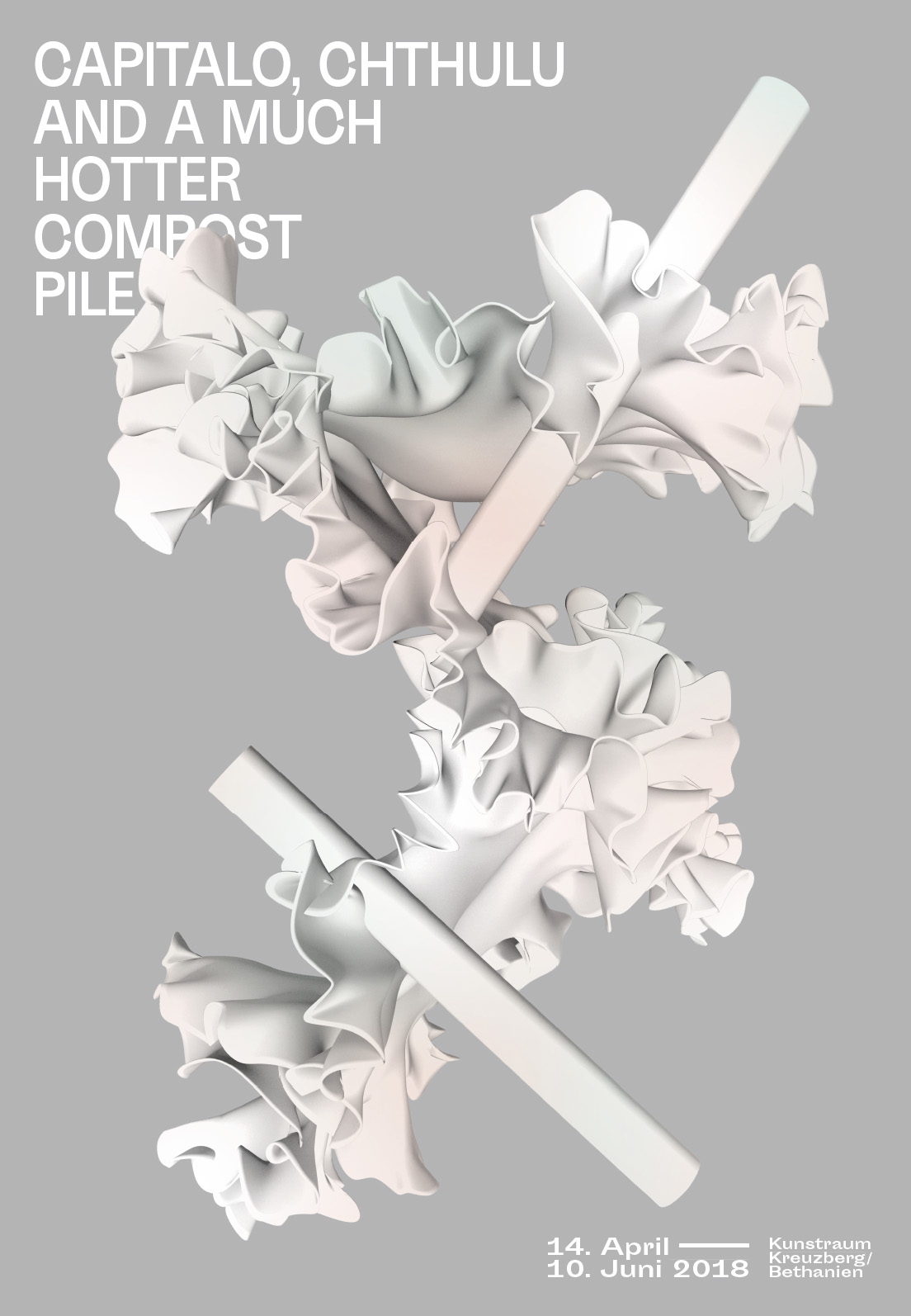Capitalo, Chthulu and a Much Hotter Compost Pile
Ana Alenso, Madison Bycroft, Shelley Etkin, Liza Dieckwisch, Sonia Fernández-Pan, Jelena Fuzinato, GeoVanna Gonzalez, Ben Greber & Bram Kuypers, Tue Greenfort, Ann Duk Hee Jordan, Femke Herregraven, Eva-Fiore Kovacovksy & Sina Ribak, Marta Leite, Herbert Lohner, Regina de Miguel, Zoë Claire Miller, Nucbeade, Naufus Ramírez-Figueroa, Anaïs Senli, Michael E. Smith, Henry Wilde & Neo Hülcker
14 April – 10 June 2018
Kunstraum Kreuzberg/Bethanien
Curated by Lorena Juan, Lena Johanna Reisner, and Anaïs Senli
“The unfinished Chthulucene must suck up the trash of the Anthropocene, the exterminism of the Capitalocene, and chipping, shredding, and layering like a mad gardener, make a much hotter compost pile for still-possible pasts, presents and futures.”1
The current moment is marked not by an ecological crisis as a temporary state of emergency, but by an irreversible mutation of the global climate and the habitability of planet Earth.2 It is a process driven by environmental pollution, ocean acidification, resource extraction, the burning of fossil fuels, agrochemical industries, and warfare, to list but a few of the anthropogenic ⎯ that is to say, human-made, factors. The term Anthropocene is commonly used to describe this very situation, giving name to a new geological epoch, defined by significant human impact on biospheric stability and geological strata.
But the term Antropocene is not undisputed. It places humanity as a whole as a singular geological agent, rendering invisible the structural responsibility of neoliberal financial elites and corporations. The Capitalocene, a concept examined for example by T.J. Demos,3 draws attention to global financial systems, highlighting the climatic impact of the capitalist political economy. Being aware of the biophysical costs of capitalism and its unequal distribution of human and ecological expenses, the current debate concerning how to think about humanity-in-nature and nature-in-humanity is a core theme of this exhibition.
The anthropocentrism and human exceptionalism, inherent in the notion of the Anthropocene, as well as the violent reinforcement of the nature-human divide that has marked western modern history, undermine attempts to think environmental strategies that are neither disengaged nor patronizing. Several works in this exhibition question and reflect on the symbolic and material separation of nature and human, for behind the naturalization of this binary lies an imperialist discourse that has not only promoted the transformation of landscapes with the single purpose of capital accumulation, but also a long history of racialized, gendered, and colonial violence.
With the aim of overcoming catastrophist and game-over discourses, the Chthulucene proposal, brought into play by Donna Haraway, advocates for a space-time of multi-species interactions and generative collaborations in a damaged world.4 This world, however, is inhabited by the so-called chthonic ones, that is earthly or subterranean creatures, inspired by mythologies and cultual practices of diverse origins as well as factual and biological realities. While the Capitalocene allows for an extended criticism, the Chthulucene refers to a kind of storytelling with strong bonds to speculative fabulation, science fiction, science fact and speculative feminism, that aims at creating more livable stories in unexpected company.
In an attempt to reject essentialist propositions and engage with postcolonial ecological thought, Capitalo, Chthulu, and a Much Hotter Compost Pile shows artistic positions that consider alternative ontological politics, reflect on environmental questions and speculate on possible narrations for our precarious times. These are stories of life (and non-life) told from the other side, to rethink how humans can fit, co-belong, co-produce, co-weave and com-post within this web of life.
- Donna Haraway, Staying with the Trouble, 2016, p. 57.
- See Bruno Latour, Kampf um Gaia, Berlin, 2017, p. 22.
- See T.J. Demos, Against the Anthropocene, 2017.
- See Donna Haraway, Staying with the Trouble, 2016.
Marta Leite
Myriad, 2011-2018
Feltpen on paper and laser printing
Dimensions variable
Scientific illustrations of the 18th-19th century tended to isolate the studied object from its context. If we take a look at animal depictions for example, they seemed to be floating in a white, empty space, delivering no information about their habitats. Also in the 19th century, a children’s card game called Myriorama became very popular. Those cards depicted people, animals and things on a series of interchangeable backgrounds, which allowed the children to combine them in different ways, creating new landscapes and stories, like editing a film. The popularity of Myriorama coincided with that of the diorama, panorama and cosmorama, inventions that served an interest in the depiction of spectacular landscapes and events. In the bestiaries of the middle ages, descriptions of real and fictional animals were confined to a symbolic and allegoric interpretation. Animals were used as moral symbols to influence human behaviour. At the crossroads of these references, Myriad investigates possible habitats for fictional animals that Leite drew some years ago, speculating about their stories, contexts and feelings to reflect on the current perspective of animal depiction, its meaning and political use.
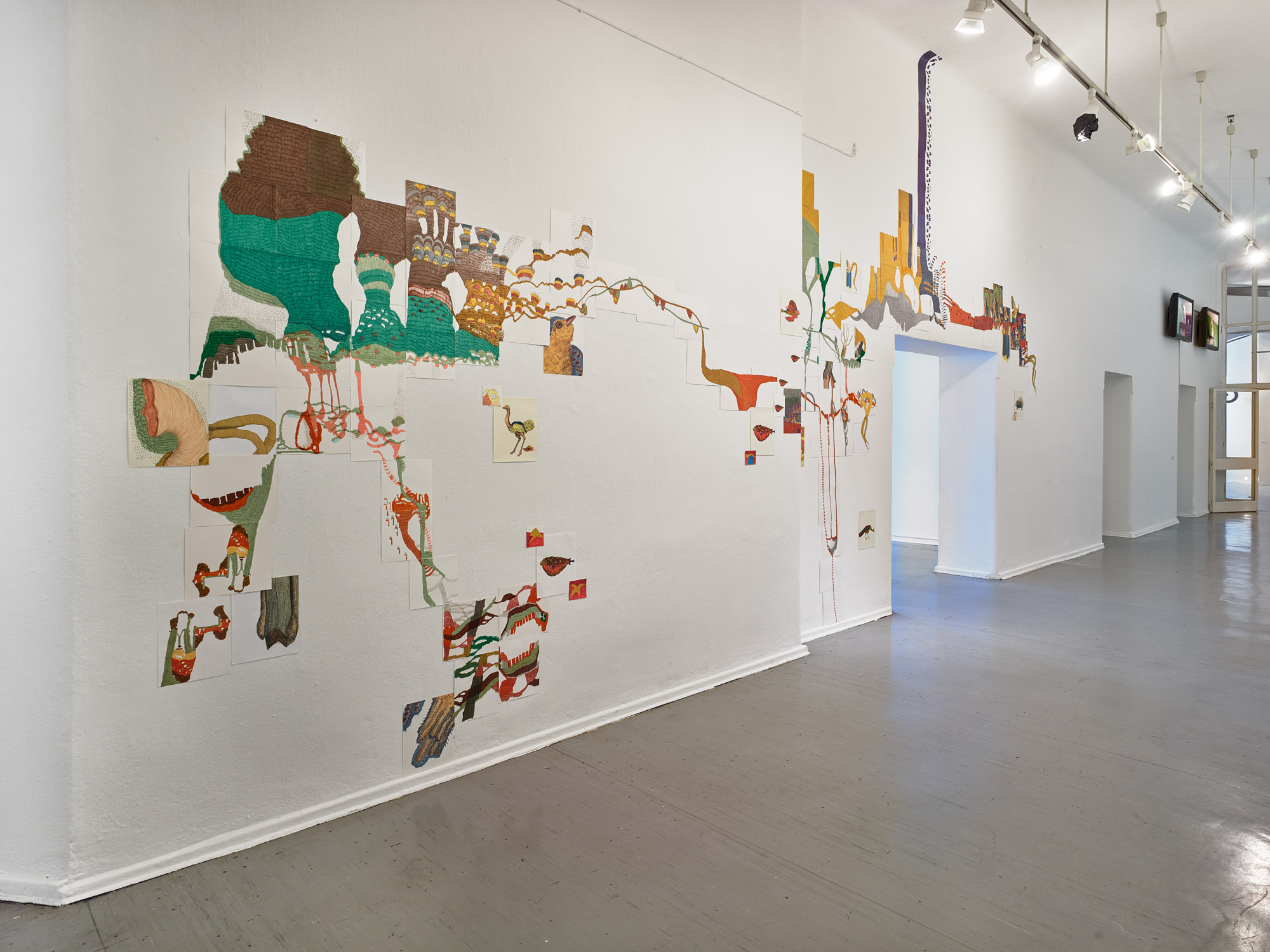
Marta Leite, Myriad, 2011-2018, installation view Kunstraum Kreuzberg/Bethanien, photo: Eric Tschernow
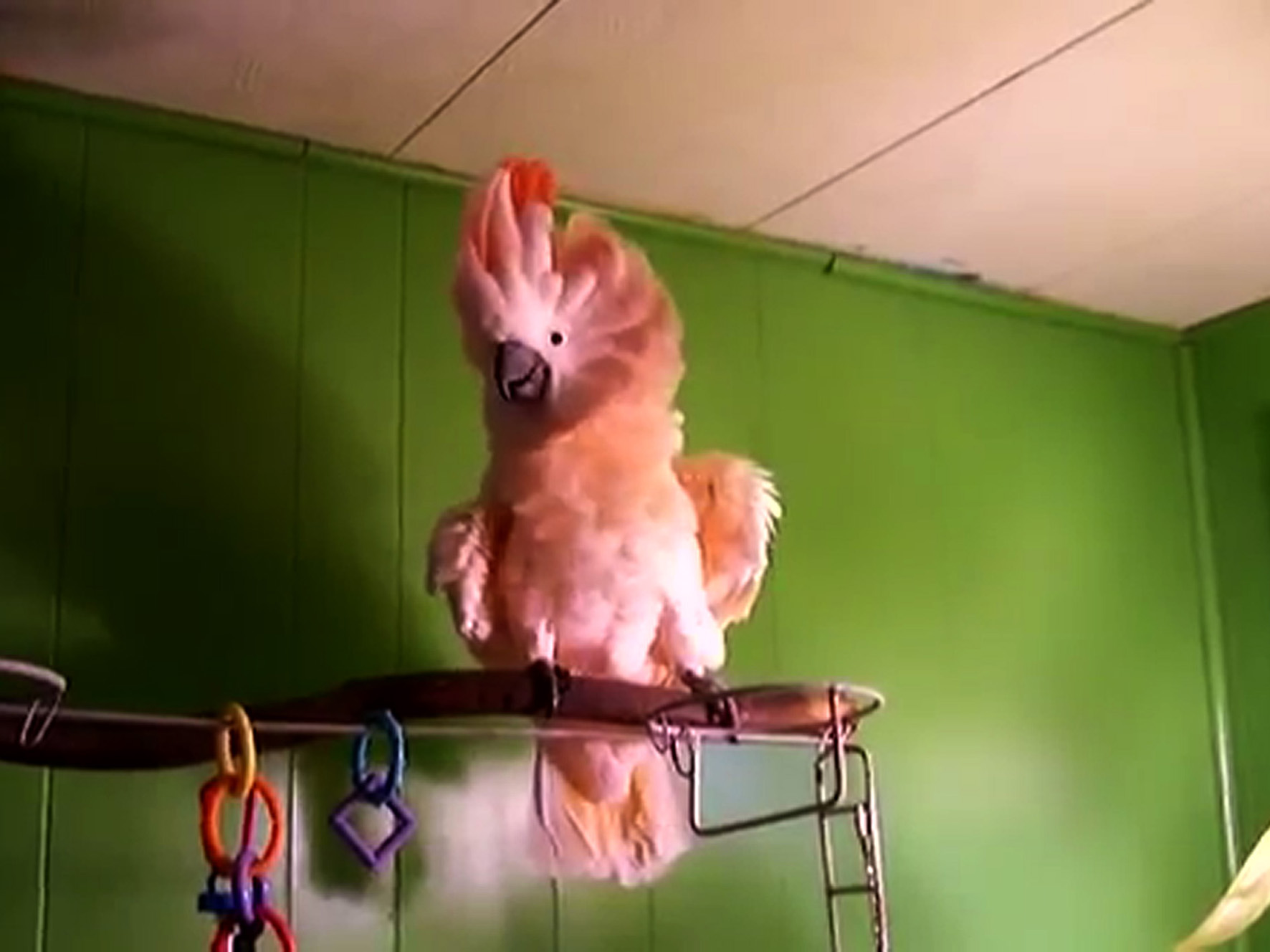
Michael E Smith, Untitled (Bird II), 2015, video still, Courtesy the artist and KOW, Berlin
Michael E. Smith
Untitled, 2015
2-channel video installation, 4:3, colour, sound, loop
Left: 3:44 min and right: 0:45 min
Untitled, 2017
Vinyl rendering of CT image
22 x 27.5 x 42 cm
Untitled, 2017
Vinyl rendering of CT image
22 x 30 x 40 cm
Courtesy the artist and KOW, Berlin
In Smith’s two-channel video work, two cockatoos star as the main characters, communicating through sound and movement in a domestic setting. Cockatoos are parrots of Australasian origin with a mostly white, grey, yellowish or pink-coloured plumage and a crest, that is either blown up or laid down according to the bird’s mood.
But the imagery of Smith is not to be understood as a sort of documentary. As aesthetic images, they have the capacity to suspend the theoretical and practical routines of our everyday relation with—and orientation within—the world, as Juliane Rebentisch might say it. With his habit of not titling his works, Smith opens up the context of his imagery to a number of possible interrelations. The found footage in his untitled two-channel video installation breaks out of the plain surface of the ordinary to present itself as a strange or even dubious occurrence.
The two objects placed on the floor are vinyl renderings of CAT-scans of dog heads. A CAT-scan is a specific X-ray test that produces cross sectional images of the body. The two sculptures thus reference contemporary imaging techniques both in terms of how the image data was produced as in how it was transformed into a sculpture. Likewise, it reminds of the presence of animals in all kinds of different laboratories, as well as the extension of human medicine to non-human companion species and livestock.
Tue Greenfort
Horseshoe Crab, Companion Species YOUTUBE Series, I , 2013/2017
Video, 12:24 min
in collaboration with Lisa Rave
Courtesy the artist and König Galerie
The Horseshoe crab is an arthropod, a vertebrate animal with an external skeleton and segmented body living in shallow ocean waters and feeding on worms and molluscs. Unchanged for nearly 500 million years, the Horseshoe crab is considered the oldest living creature on Earth, and often referred to as a living fossil.
Greenfort’s Horseshoe Crab, Companion Species YOUTUBE Series, I investigates the historic relationship of the animal with human civilisations based on found footage material, referencing the concept of the companion species first brought into play in Donna Haraway’s Companion Species Manifesto.
Greenfort’s video compiles footage of people interacting with Horseshoe crabs on the beach as a tourist attraction, of people handling the animal while explaining their physiology, explanatory footage of the Horseshoe crab’s use in the farming industry, its appearance in ancient Chinese paintings, as well as footage from laboratories.
For several decades now, the biomedical industries have been mining the Horseshoe crabs for their blood, which is of blue colour and considered the medical equivalent of gold. Around 250,000-500,000 Horseshoe crabs are collected every year and deprived of a third of their blood before being released back into the ocean. The amebocytes comprised in their blood is used for blood tests and the detection of bacterial endotoxins in medical applications.
Horseshoe Crab, Companion Species YOUTUBE Series, I can be understood as a portrait, however, it is not the portrait of one species but of a series of encounters and complex interrelations of more than one kind–one of which is human.
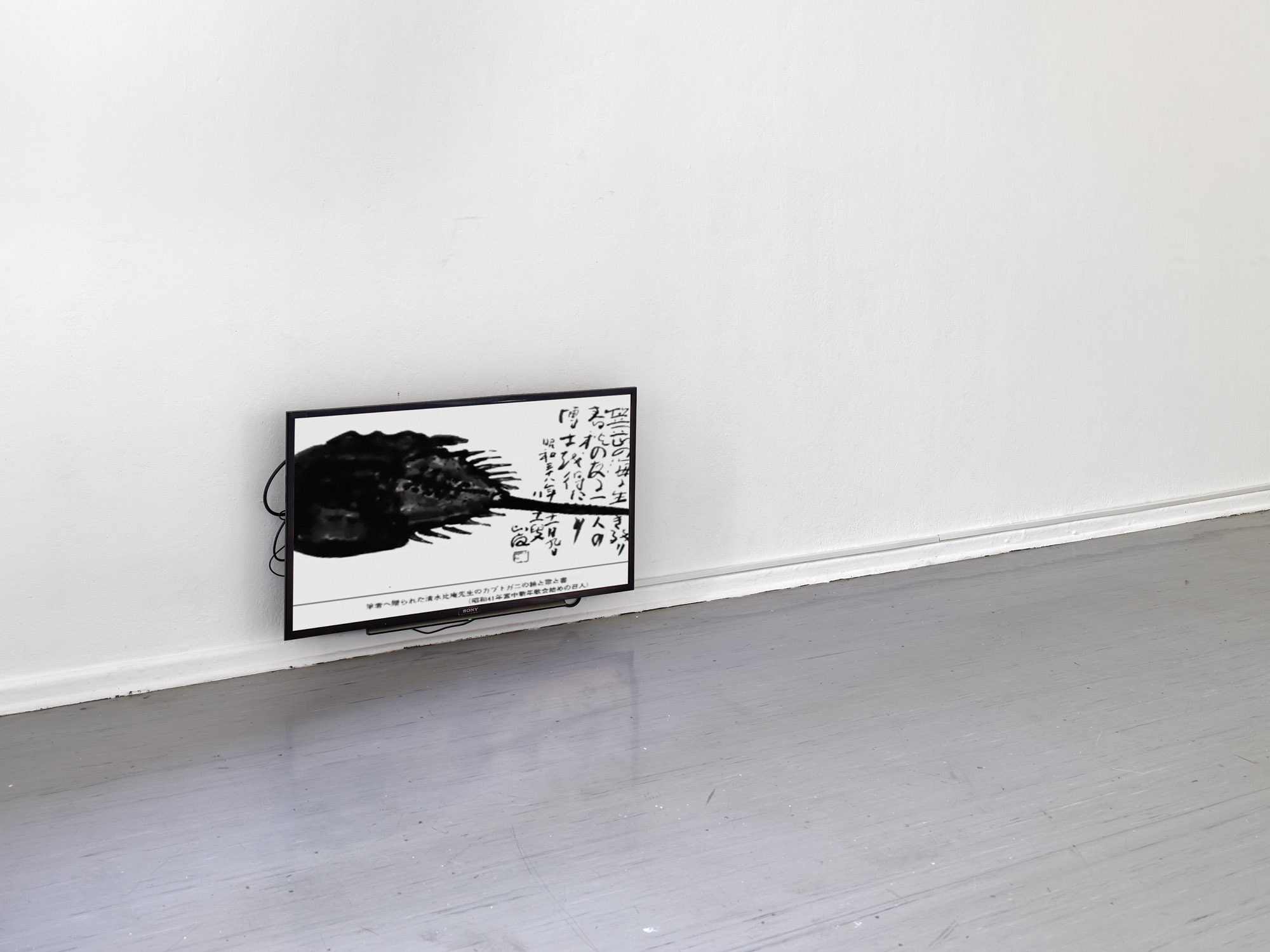
Tue Greenfort, Horseshoe Crab, Companion Species YOUTUBE Series, I, 2013/2017, installation view Kunstraum Kreuzberg/Bethanien, photo: Eric Tschernow
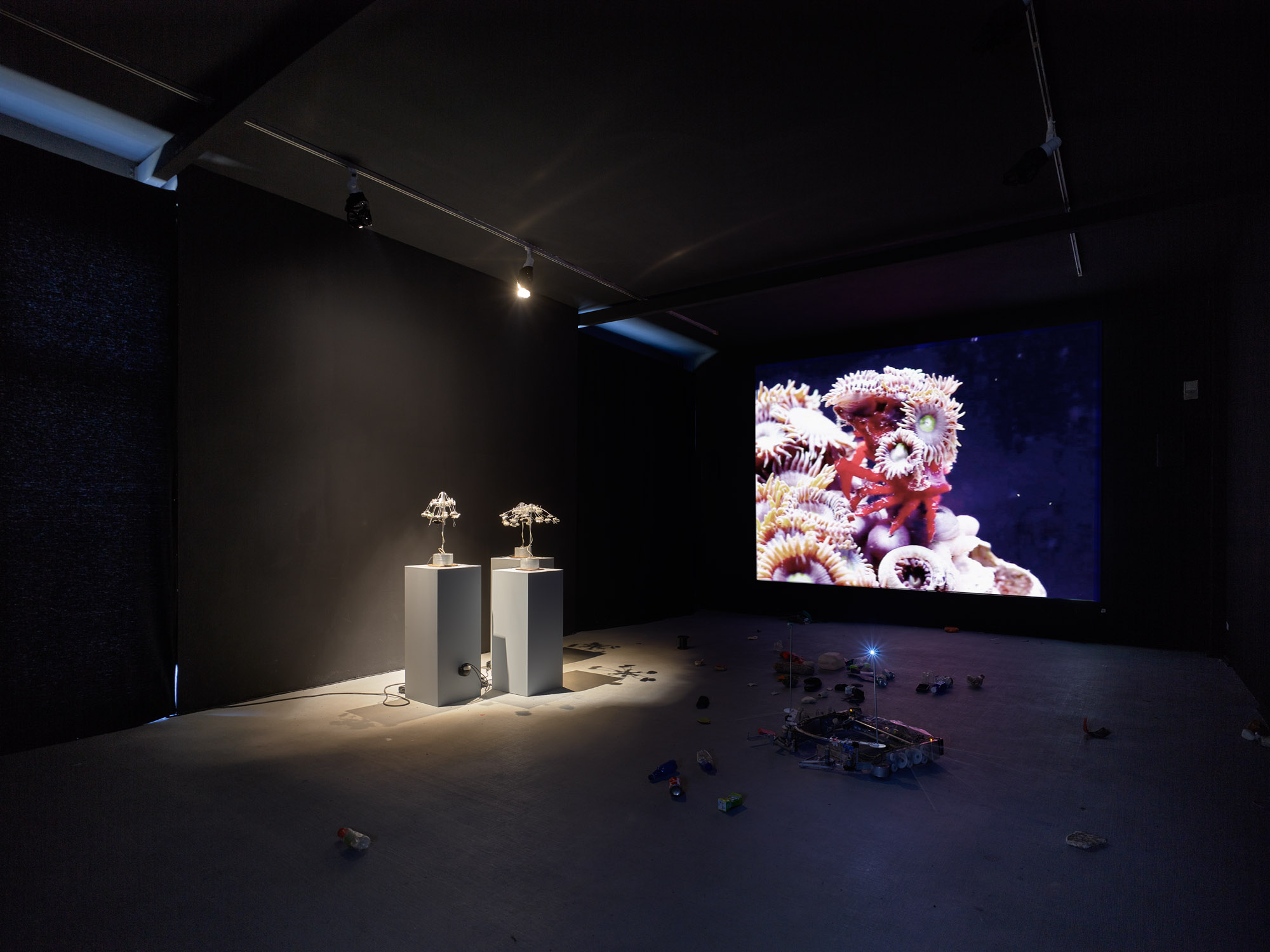
Anne Duk Hee Jordan, Ziggy and the Starfish, 2016-2017, installation view Kunstraum Kreuzberg/Bethanien, photo: Eric Tschernow
Anne Duk Hee Jordan
Ziggy and the Starfish, 2016
HD-video, 16 min
Documentary about Ziggy and the Starfish
HD-video, 21 min
Robotic Waste Crab, 2016
Motor, mechanics, garbage, 17 cm x 90cm x 180 cm
Singing Stones, 2017
Fossils, stones, engines, 56 cm x 49 cm
Jordan’s Ziggy and the Starfish comprises a mechanical waste-processing crab, a video work focusing on fish erotica, interviews with marine experts, and a stone-based sound installation.
By focusing on aquatic life, Jordan creates a multimedia environment exploring an alienate universe full of strangeness, mutation and adaptation. Pollution through traffic, oil drillings and oil spills, but also deforestation, urbanization and overfishing have brought the oceans to the verge of collapse. An almost invisible — yet undeniable — change in the ecology and sexual behaviour of marine life is occurring.
Meanwhile, a mechanical crab collects the garbage from the ocean and eats it. After approximately 6 cycles, with Sisyphean effort, the crab throws the waste via a catapult and starts anew. A sound installation comprises stone fossils and neo-minerals dating back 65 million years to the last extinction. Jordan’s geological mementos become inanimate cyborgs humming a song from the past to a present’s audience.
Ana Alenso
Water, Oil and Bio-Orange Juice, 2015-18
Barrels, water bottles, decorative fountains, water, mirrors, metal remains, lamps, net
Dimensions variable
The installation Water, Oil and Bio-Orange Juice suggests a decadent, post-industrial scenario. Barrels, water bottles, pipe remnants and scaffolding parts are provisionally displayed to allow for a critical consideration of a common understanding of nature and the practices of extractivism. With the selection of objects, the artist reflects on the danger of the pollution of water bodies and drinking water as a result of the extraction of natural resources by methods such as hydraulic fracturing. Water, Oil and Bio-Orange Juice can be read as an allegory of environmental, social and economic risks and imbalances, particularly in relation to the oil industry and the diverse practices of resource extraction and exploitation. Therefore, all parts of the installation are in a state of precarious balance, neither fixed nor held together. The equilibrium and tension between the elements as well as the use of resources and, ultimately, the conservation of them, characterizes the work.

Ana Alenso, Water, Oil and Bio-Orange Juice, 2015-18, installation view Kunstraum Kreuzberg/Bethanien, photo: Eric Tschernow
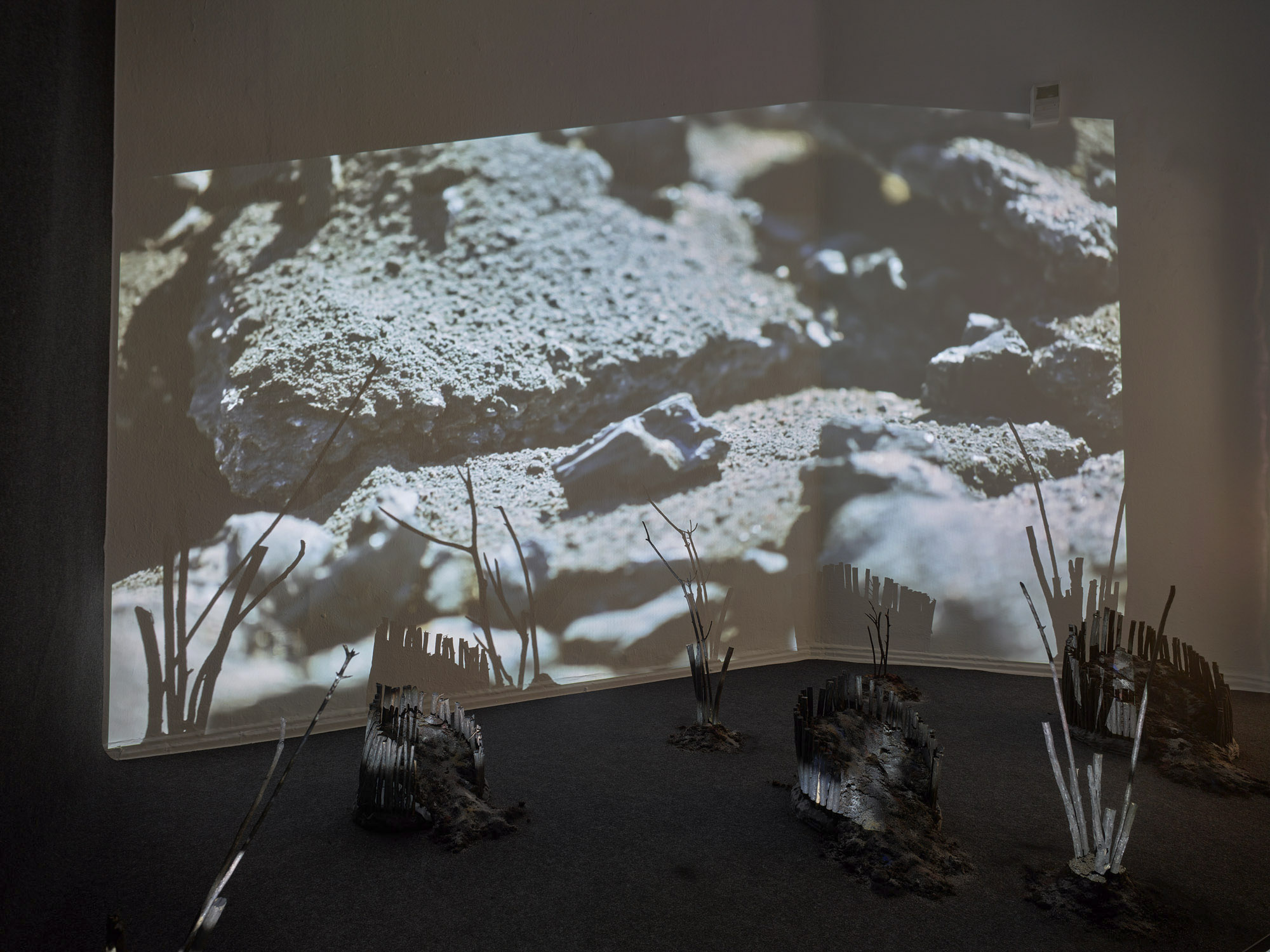
Anaïs Senli, Fire Point, 2018, installation view Kunstraum Kreuzberg/Bethanien, photo: Eric Tschernow
Anaïs Senli
Fire Point, 2018
HD video looped, 7’40 min., stereo sound, burnt branches, carpet, sand, pigment, fluorescent paint
Sound: Didio Pestana
The projected images could come from a non-terrestrial landscape, a fictional place, apparently inert, with rare and subtle movements occurring only from time to time. Structures are dispersed on the ground reminding of uncanny geological or organic formations, residue of burnt vegetation. The video then guides the viewer to a more recognizable place: the remnants of a burnt forest.
The images of the burnt forest and the sound of the cicadas were both recorded in Andratx, Majorca, after a forest fire in 2013, whereas the branches on the ground were taken from a burnt forest near Barcelona in 2018. Spain is one of the countries with the highest number of forest fires in Europe, almost all of them caused by human activity. However, there is little effective regulation for this problem. Public resources continue to be allocated primarily to active firefighting, neglecting detection and prevention. Though especially severe in Spain, other Mediterranean countries in the European Union suffer equally under such circumstances. Still, on the level of the European Union, the common Community Forestry Policy is incomplete and uncoordinated.
The debate around the Anthropocene and the Capitalocene in particular has highlighted the impact of colonial and industrial activities on ecosystems all around the planet. Fire Point departs from one of many cases, reflecting on the importance of a more sustainable environment and healthy forests. Emphasizing the planet’s strangeness and the feeling of desolation, Fire Point simultaneously intends to bring to mind the need to find collaborative strategies that help us to live in a world that is becoming unrecognizable.
Femke Herregraven
Seismic Parallax, 2017
2 salt prints, silver nitrate (collected in the Danakil Depression), Ethiopian salt, Hahnemühle Platinum Rag, 100 x 70 cm
Courtesy the artist and Future Gallery
Seismic Parallax is a diptych of salt prints reflecting on the collision of two optical orbits in the same geographical area. The first image shows the Whirlpool Galaxy – also known as M51 – at 30 million light years away. It was taken as one of the first images of the recently opened Ethiopian space observatory. As a telescopic image operated from the ground, it speaks of the technologically advanced human perception and its timeless motive of staring into the sky.
The second image depicts a volcanic eruption in the Danakil Depression in Northern Ethiopia, considered the hottest place on Earth in terms of yearly average temperatures, and likewise one of the lowest-lying areas on the planet. With three tectonic plates meeting in the Danakil Depression, it is marked by volcanic activity and geological instability. Its landscape is covered by salt lakes and hot springs populated by with extreme microorganisms, which are of major interest to astrobiologists. The image was captured from outer space after artificial intelligence software operated by a swarm of satellites detected changes in an underground lava lake. The satellite swarm predicted and captured the volcanic eruption in an early stage even before the scientists took notice.
Both digital images are reproduced with salt collected in the salt desert surrounding the volcano in the Danakil Depression. As a diptych they confront a view from above with a view from below, both mediated through advanced technologies. Realised with a material indigenous to the Danakil Depression, the digital images consisting of abstract sets of data find their way back into material concreteness. It is a procedure that raises questions of how to represent or approach a landscape, how to measure the world in scientific terms, how to make use of specific resources and how to relate to outer space–to that which goes beyond and still forms part of the world’s broader ecosystem.
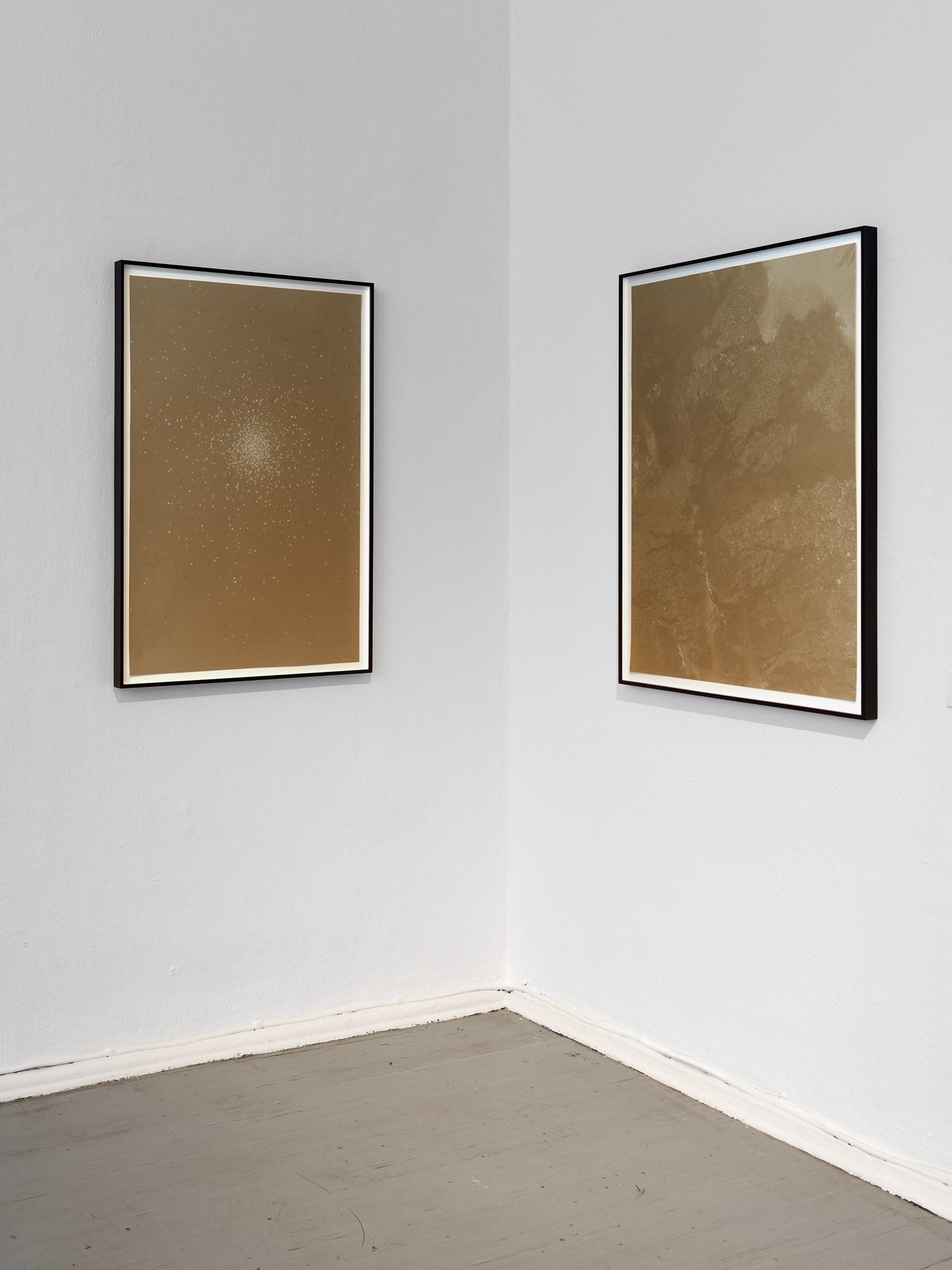
Femke Herregraven, Seismic Parallax, 2017, installation view Kunstraum Kreuzberg/Bethanien, photo: Eric Tschernow
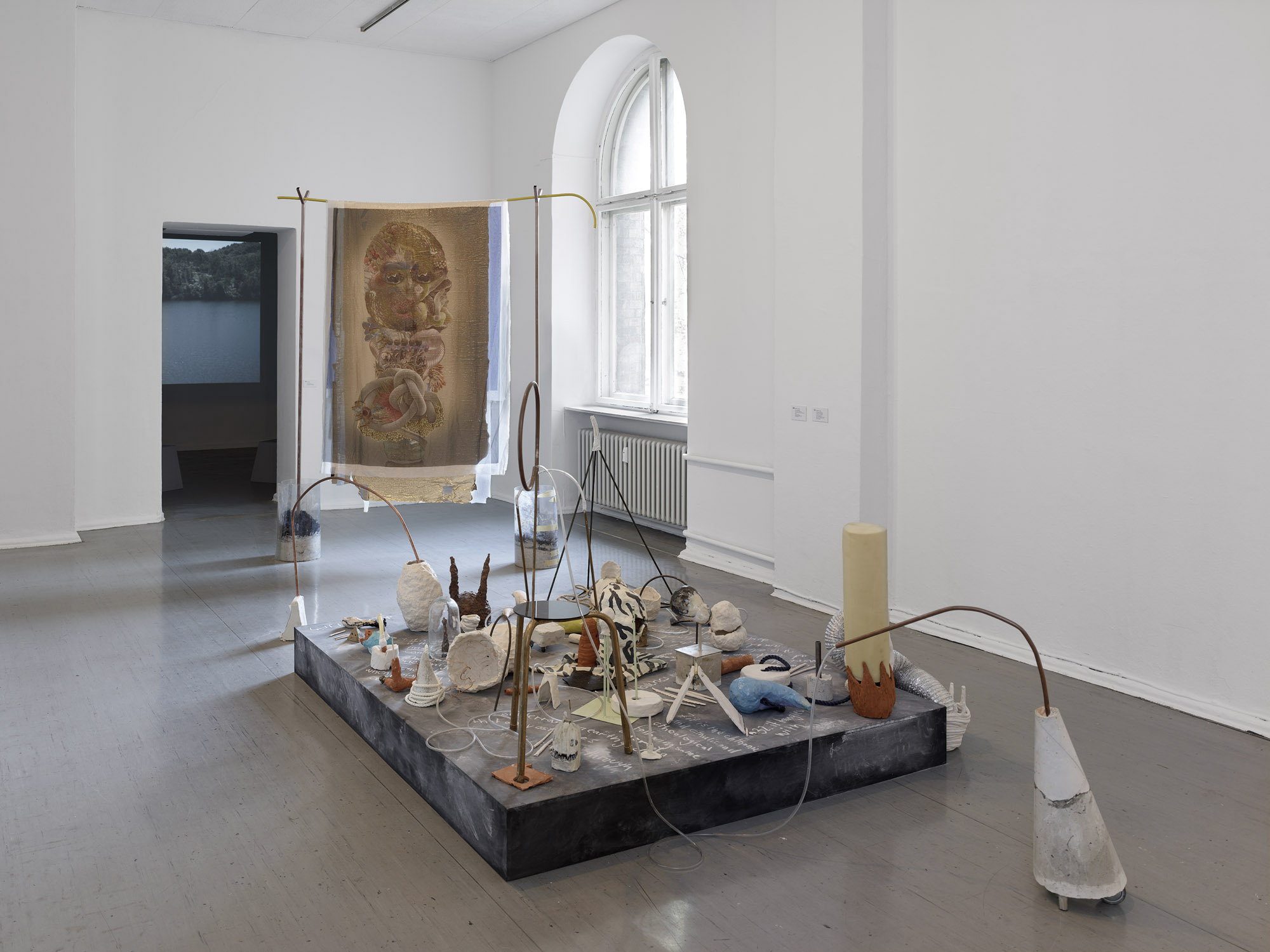
Madison Bycroft, In Praise of Ignorance: Taxonomy Table, Chthonigoegigoog or speculative artefacts for invocation and measurement, both 2016, installation view Kunstraum Kreuzberg/Bethanien, photo: Eric Tschernow
Madison Bycroft
In Praise of Ignorance: Taxonomy Table, 2016
Wood, paint, chalk, fired and unfired stoneware, plaster, concrete, steel, plastic pipe, rope
Dimensions variable
Chthonigoegigoog or speculative artefacts for invocation and measurement, 2016
print on silk, different materials
Dimensions variable
The Bunyip is a creature referenced by many Indigenous Australian peoples, that dwelled in swamps, billabongs, riverbeds, creeks and water holes. When British settlers began to describe and classify the flora and fauna of Australia they followed a standardised, scientific procedure that privileged only what they themselves saw. Singular, white, colonial vision and epistemologies formed the basis of a knowledge with an ontological hierarchy that discredited anything outside of that. In Praise of Ignorance: Taxonomy Table is an attempt for a different kind of classification. How might we imagine or decolonise our imagination in regards to the unsaid, unseen creature. Fragments of text are written in chalk on a black, stage-like platform. Sculptural elements are variously connected by ropes, tubes, rods, pipes and ducts, provoking thoughts about an overarching ecological principle of the interconnectedness of all beings.
“Chthonic” means “in, under or beneath the earth” but also “subterranean”. Madison Bycroft’s Chthonigoegigoog or speculative artefacts for invocation and measurement operates with this lexical root and presents artefacts which are to be understood as suggestions and forms of speculation.
Ben Greber & Bram Kuypers
Ben Greber
Alles steuert der Blitz (2013/16)
video, 11:37 min, loop
Bram Kuypers
The Road To Success (2016)
Site specific installation, floor elements of a poultry farm
Dimensions variable
Kuypers installs the wooden floor of a poultry house in the gallery space, raising questions about for whom, or rather for which species, the space was designed. The second-hand wooden structure still bears the visible and perceptible traces of its former use. Such traces of the presence and absence of life create a void—a void that is characteristic of the Anthropocene.
Greber’s video Alles steuert der Blitz consists of two photographs of the same architecture with each a different exposure. Alternately appearing in the projection the structure of a suburban train stop with three street lamps is first hidden in darkness and then revealed. The scenery of a concrete structure with flickering lights, empty of people, gives the impression of a ghostly presence, as if something was not right.
The two works were first shown together during a residency in North-Rhine Westphalia, where surprisingly they turned into something of comment on the notions of presence and absence in the Anthropocene. Kuypers The Road to Success borrows its title from a manual for racing pigeons and thus examines yet another interspecies relationship.
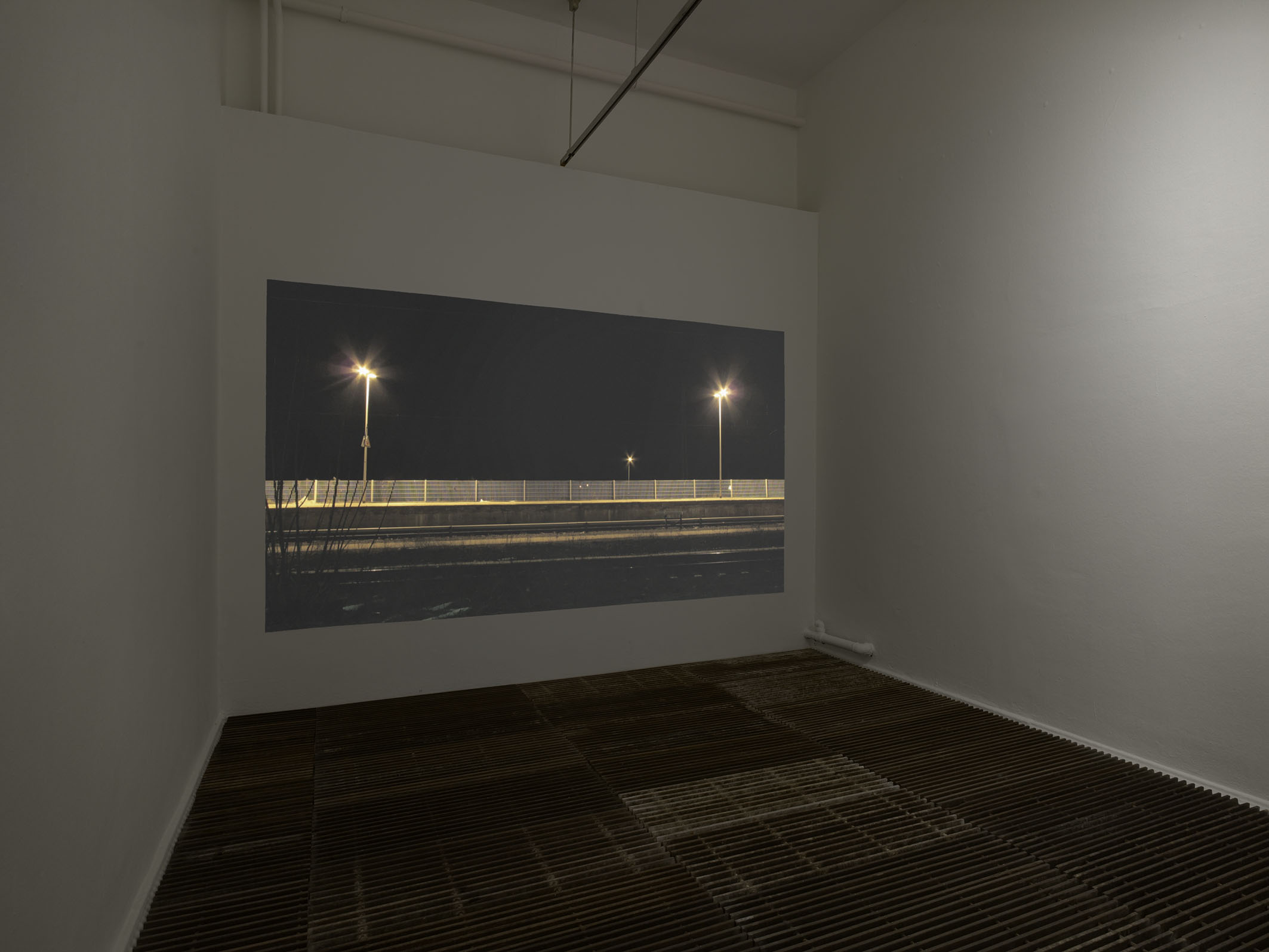
Ben Greber & Bram Kuypers, Alles steuert der Blitz, The Road To Success, 2013/16 and 2016, installation view Kunstraum Kreuzberg/Bethanien, photo: Eric Tschernow
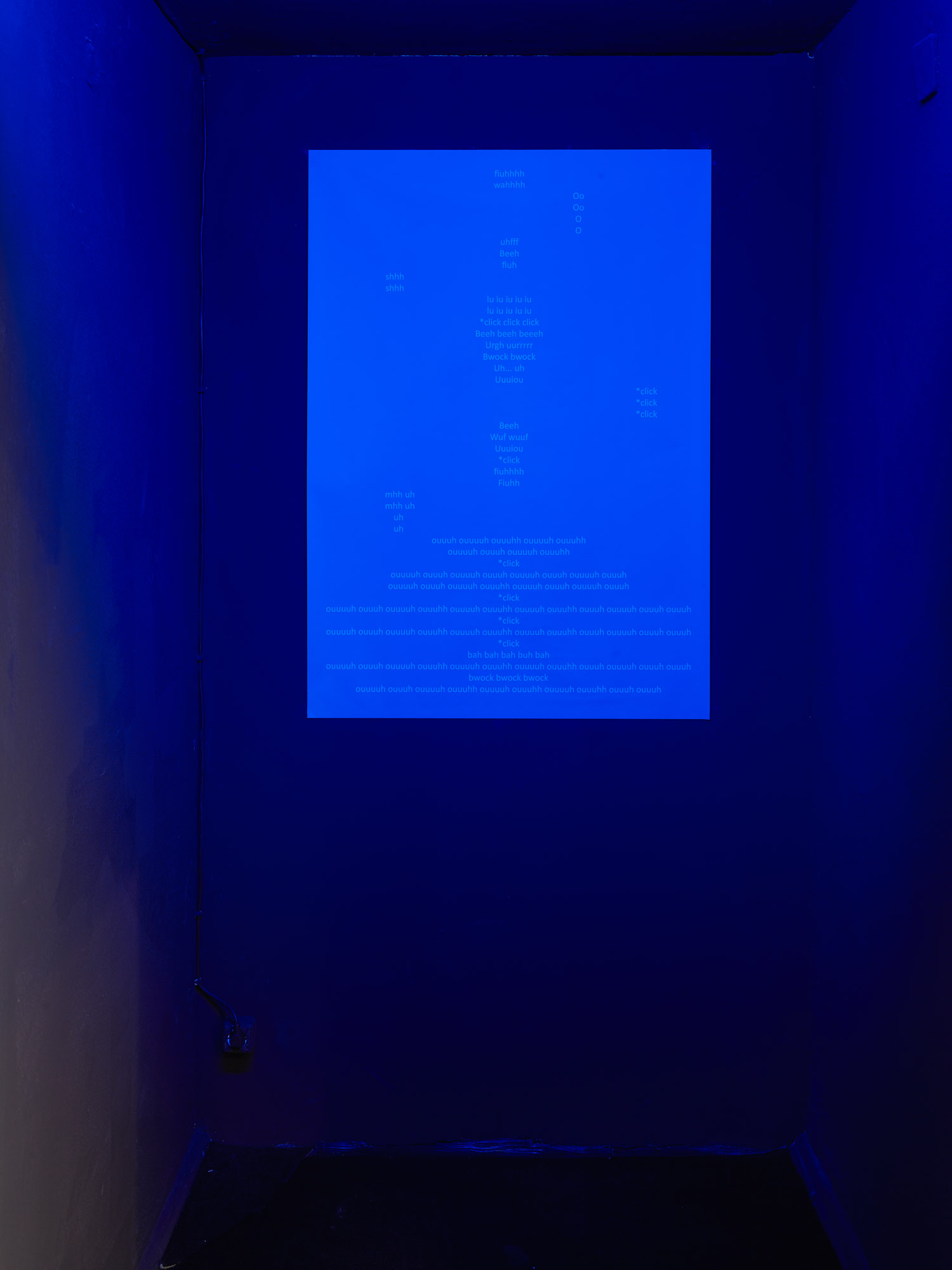
Naufus Ramírez-Figueroa, Séances with Extinct Species of Birds, 2012-ongoing, installation view Kunstraum Kreuzberg/Bethanien, photo: Eric Tschernow
Naufus Ramírez-Figueroa
Séances with Extinct Species of Birds, 2012-ongoing
Sound, score
Dimensions variable
Courtesy the artist and Galerie Barbara Thumm
Since 2012, the artist has conducted spiritualist sessions to establish contact with extinct species of birds. As an exercise in imagination and cross border communication, the participants experimented with their voices and breathing to reach an alternate state of receptivity. While there exists no visual documentation of the sessions, the collective process manifested in a sound work and a score similar to an arrangement of linguistic elements as known from concrete poetry. Séances with Extinct Species of Birds contemplates on species extinction, sonancy and transcendence through engaging with a performative, ritualistic practice outside the scope of modern traditions.
Born in Guatemala, Ramírez-Figueroa often picks up on the ciphers of a tropical flora and fauna. The political history of the country as well as the cultural legacy of Latin America equally tend to influence the thematic reflections of is oeuvre, which bears similarities with surrealism, theatre and notions of the spiritual in dialogue with contemporary culture.
Liza Dieckwisch
Kompost, 2012-16
Acrylic, latex, silicone, tinsel, plastic foil
50 x 12 x 25 cm
Coming from a painting tradition, Dieckwisch’s works find their inspiration in experimenting with diverse materials such as latex and silicone. Although mostly synthetic, Dieckwisch’s works share similarities with organic life forms in structure and arrangement. Her compositions seem to feed upon a shared body out of which clear pictures emerge from time to time, only to be reabsorbed and fashioned into something new once they leave an organised exhibition space.
With a curiosity about foodstuffs and the poetic potential of recipes, Dieckwisch’s visual practice reminds the viewer of tactile and gustatory experiences, as well as edible and degradable materials. In a compost-like object, fragments of sketch-like experiments and relics from earlier works embark upon a further phase of their cycle.
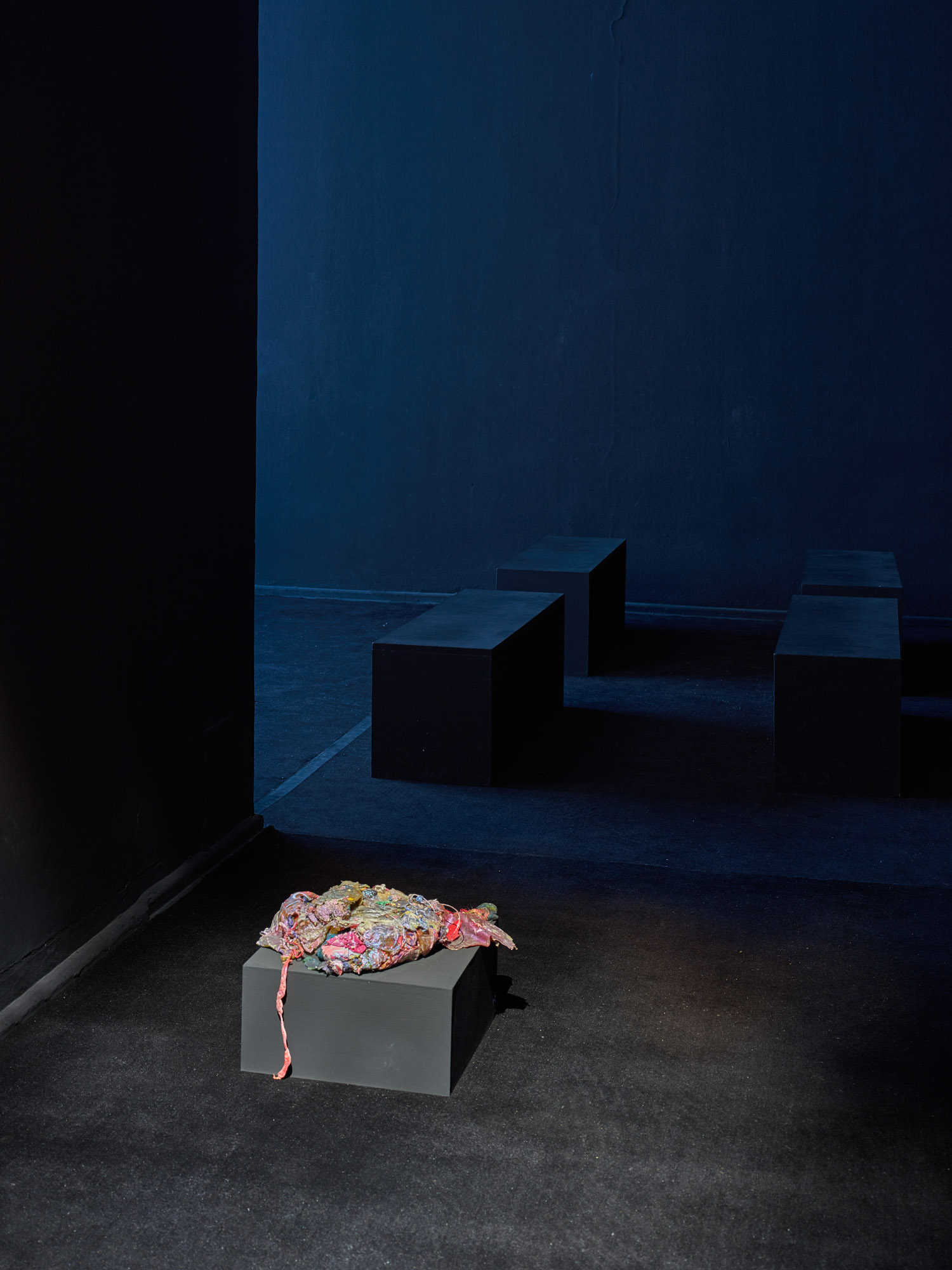
Liza Dieckwisch, Kompost, 2012-16, installation view Kunstraum Kreuzberg/Bethanien, photo: Eric Tschernow
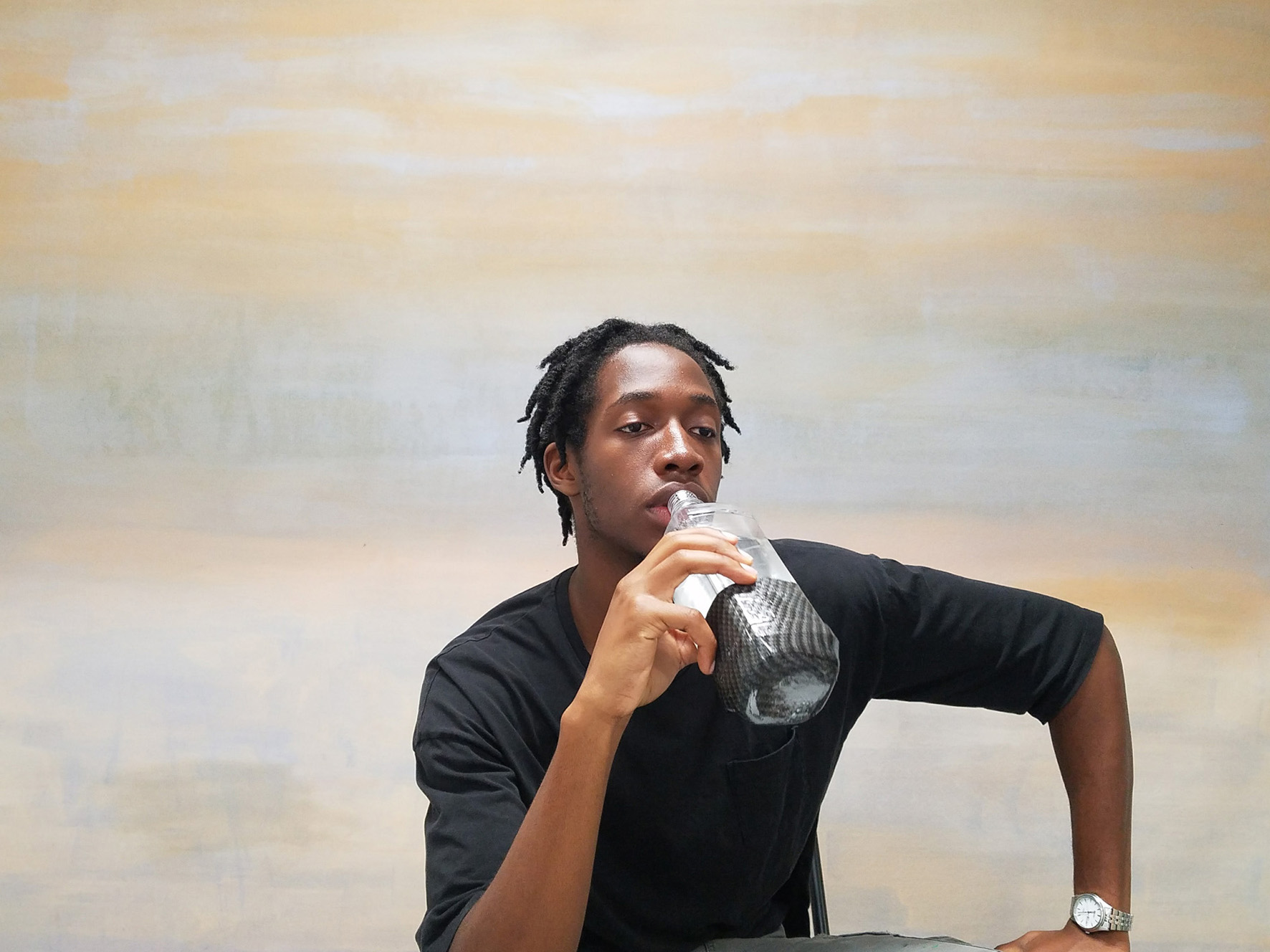
GeoVanna Gonzalez HOW TO: Lean Forward, Test Solutions (A few things that make the eyes weak), 2018, video still, Courtesy the artist
GeoVanna Gonzalez
HOW TO: Lean Forward, Test Solutions, 2018
Mixed media
Dimensions variable
Gonzalez’ practice explores the influence of both the organic and the technological in currently shifting notions of gender and identity. She infuses the dominant virtual-visual realm back into the haptic-human world, as a way of investigating different and deeper ways of seeing through, being in, and altering the environment.
The installation is part of a series called HOW TO, which runs concurrent to the online poetry collection tutorials (www.tutorials.fyi) by Martin Jackson for which Gonzalez is making work as a way of open source translation, and versioning, or reappropriating the ideas, imagery and language of poetry.
HOW TO: Lean Forward, Test Solutions immerses the viewer in an interactive scenario. The segmented landscape explores how aesthetics can be used as a strategy for survival in our local and global environments through simulation, adaptations and or camouflaging. For example, the branded water bottles that appear throughout the installation are used as a source of growth; presented as sculptural objects as well as a subject in her video piece. The piece is intended as a form of speculative reimagining or fictionalizing our experience of the world that prompts the viewer to draw connections between these glimpses from an alternate reality and the looping words of the poem itself.
Zoë Claire Miller
Candid Canids, 2018
It is said that the first dog was a wolf that gave up its independence to seek permanent employment among cavemen. The employment contract signed in this evolutionary niche included hunting support, guarding, companionship; the payment was made in scraps of meat. What are the delicate links in the cross-species interdependence between canids and hominids? Who owns, who is possessed? Miller’s video and sculpture trace several hominid-canid encounters and symbioses in Mexico and Germany, attempting to encounter dogs on equal terms.

Zoë Claire Miller, Candid Canids, 2018, video still, Courtesy the artist
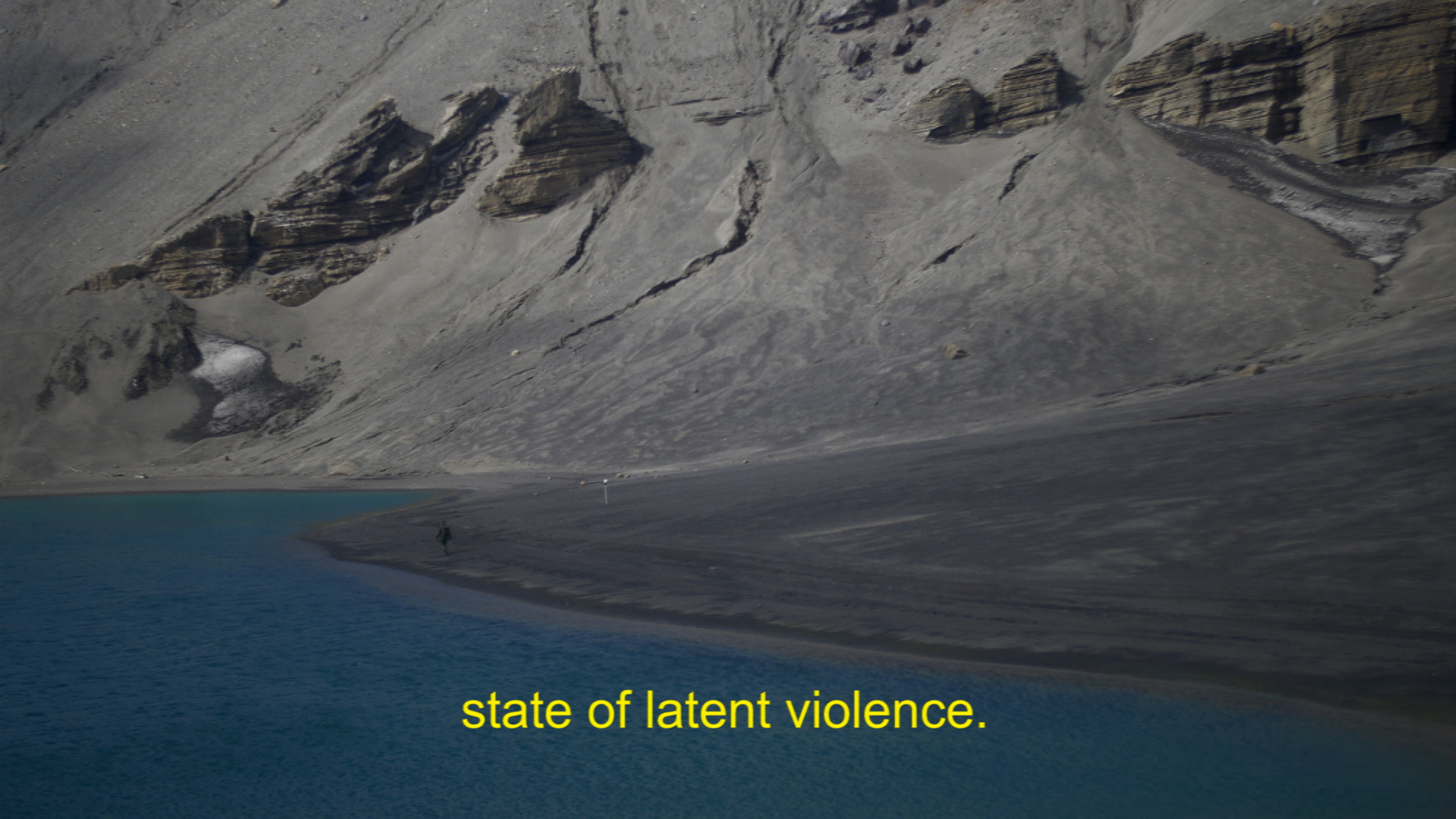
Regina de Miguel, Regina de Miguel_DeceptionDecepción, 2017, video still, Courtesy the artist
Regina de Miguel
Decepción, 2017
HD video, colour, sound, 28′ 19”
Original soundtrack: Lucrecia Dalt
Decepción is a speculative fiction, a travel log and the story of an internal or existential displacement set before the mytho-poetic backdrop of Deception Island in the Antarctic. Based on the post-abyssal thinking of Boaventura de Souza, an inner monologue reflects on the idea of the South and an invisibilised humanity. The narration deals with the existence of extreme life forms which—until recently — were inconceivable to science, which has always measured survival according to anthropocentric notions. On Deception Island, which is the terrestrial analogue closest to planet Mars, the possibility of a biosphere in darkness and microbial life on other planets is being explored.
Departing from this journey and guided by a voice that dovetails with the imaginaries already conjured up by Poe, Verne, Lovecraft, and Lispector Decepción invites us to imagine ourselves as the fossils of a future universe.
Nucbeade
ШАГ, 2018
HD video 13’ 53’’
Original language Spanish (with English subtitles)
ШАГ (Russian): Side step, dancing move
ШАГ is a science fiction movie or a filmed performative act of several bodies that inhabit a space of exile outside the binary code. Far from being objectified, consumed or romanticized, nature is just another character in the piece; a queer body that dances without music on hierarchical archetypes.
Reappropriating the error as their tool of resistance, the aim of the protagonists in the videowork is to surpass the limits of their own corporeality, to merge into a glitch of non-canonized topography. These abject subjects embrace a visual and sonic landscape of interferences and revenge historical violence by rejecting the norm.
Nucbeade is a collective formed by the artists Quiela Nuc and Andrea Beade. Their work deals with queer performativity and its relation with landscape, focusing on non binary strategies by merging performance, moving images and code hacking.
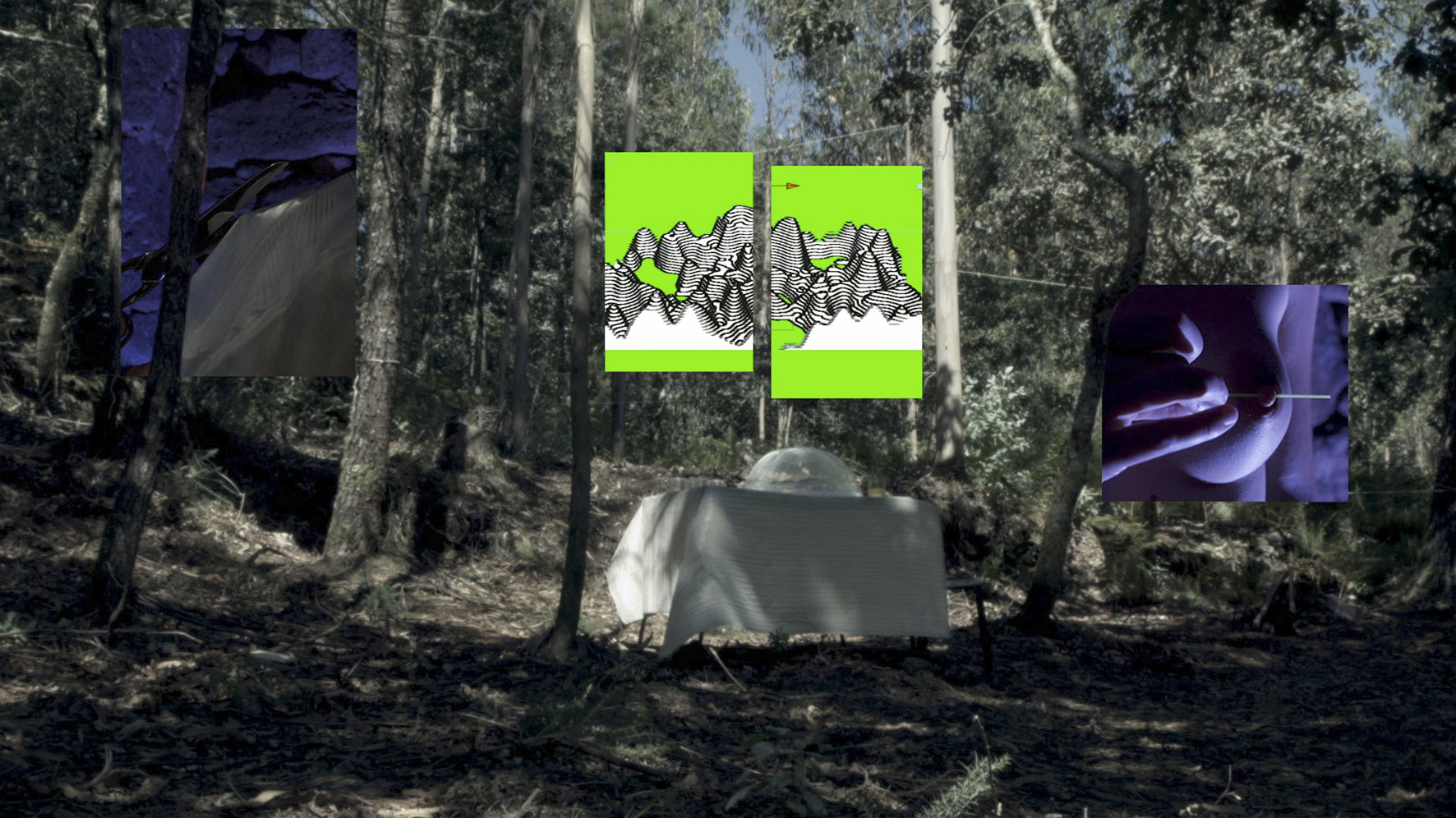
Nucbeade, ШАГ, 2018, video still, Courtesy the artists
Shelley Etkin
Landing Sessions
Series of One-on-One Performances
15-16 April 2018
Landing Sessions explores experiential methodologies for the mutual communication with land. During the sessions, participants are facilitated through somatic and psychic journeys which track sensations, visualizations, and reflections.
Landing Sessions is an experiment in imagination, divination, meditation, bodywork, and sense-making. Hand-drawn symbols offer portals to an experiential journey where multiple readings of land and place overlap and form a sort of immaterial garden of forces, that shape the material world. Rather than a territorial notion of land, these sessions approach ‘landing’ as a process, a queer morphology, a verb, a shared becoming with land through a journey.
Sonia Fernandez Pan
Be good, I love you
Speculative & emphatetic gathering. Non-humans are welcome
9 May 2018, 19:27
Is it possible to become plastic? To become chocolate? Your daily breakfast mug? How about becoming global warming? Can we become objects, things? Can we embody other bodies through empathy? Can we relate to each other within these “new bodies”? Can we think through systems of interactions rather than individuals? Furthermore, can we behave as systems of interactions rather than thinking about them? Maybe it is as simple as trying a collective exercise of empathy in relation to some of the non-human entities that join us in our life experience every day. But don’t worry, succeeding is not important. What matters is that, at least, we try.
Herbert Lohner
Environmental justice – do we have the right to a healthy environment?
Lecture and conversation
17 May 2018, 19:30
More and more people are suffering from health problems, the cause of which they see in the environment. In a complex and interconnected world, people have great difficulties assessing environmental and health risks in their immediate neighbourhoods. The scientific assessment and the social perception of health risks caused by environmental influences sometimes diverge, and the effects and acceptance in politics, science, economy and population are highly controversial.
How can we politically engage and create practical solutions? In Berlin, with support from the BUND, a model was developed on how Berlin could make its way to becoming an environmentally-friendly city.
Herbert Lohner, who works as a consultant for the organization, will discuss the repercussion of this model at a national and international level, as well as current local policies. Do we have the right to a healthy environment?
Eva-Fiore Kovakovsky & Sina Ribak
Between Us and Nature – A Reading Club
#10 Session Grief:
30 May 2018, 19:30 – 21:30
#11 Session Hope:
6 June 2018, 19:30 – 21:30
In Between Us and Nature – A Reading Club participants read together texts related to natural sciences, art, anthropology, postcolonialism, and (post)anthropocene, chosen from a female perspective looking beyond disciplines.
Each session is a new constellation, a mix of people from diverse backgrounds forming the Reading Club. During the sessions, the participants spontaneously and intuitively explore texts, reading between the lines, stimulating exchange and gaining perspectives.
Eva-Fiore Kovacovsky, artist, and Sina Ribak, environmental & cultural manager, invite the attendants to be inspired and reminded of nature’s ability to hold us in the moment to force us to inhabit the present.
Henry Wilde & Neo Hülcker
Tentaculus Ohri
A collection for unplugged listening
Two-on-one performance
Helping ears: Mia Sellmann, Hannah Levin
Duration: 10 min per person
31 May 2018
17:00-21:00
Tentaculus Ohri is a piece for one listener and two performers. Henry Wilde and Neo Hülcker will present their collection of animals and nature elements in a two-on-one performance. The visitor will wear a hearing apparatus specially designed by Hülcker and listen to nature and animal sounds from their archive. It will be very silent and one will learn about the perception of a *blättrige Langschwanzanglerin*. Some audience members will be allowed to watch. The listener will become a little owl.
Credits
Curators: Lorena Juan, Lena Johanna Reisner, Anaïs Senli
Graphic design: Tea Palmelund
Texts: the curators and participating artists
Translations: Inga Imrich, Kristina Kramer, Zoë Claire Miller
Proofreading: Conor O’Rourke, Lena Johanna Reisner
Project assistance: Alexa Reinhart, Alice Royoux
Head of technical team: Hannah Ditioma Haraldsen
Technical team: Nicolás Gómez, Michael Hoepfel, Tibor Horvath, Anka Mirkin, Kerstin Podbiel, Serkan Servincili
Director of Kunstraum Kreuzberg/Bethanien: Stéphane Bauer
Courtesy the artists for all works if not mentioned otherwise
A project of Kunstraum Kreuzberg/Bethanien, supported by the Senate Department for Culture and Europe: Exhibition fund for municipal galleries, fund for artist remunerations. Supported by a project grant of the district office Friedrichshain-Kreuzberg and the Spanish Embassy in Berlin.


























